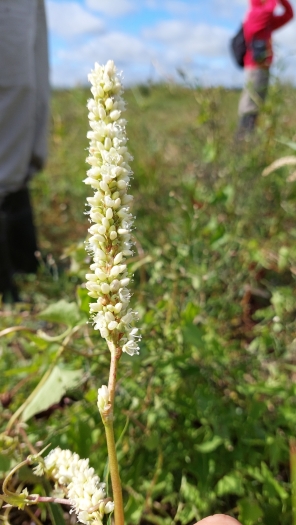Tapertip Knotweed
(Persicaria acuminata)
Tapertip Knotweed (Persicaria acuminata)
/
/

Tomás Tamagno
CC BY 4.0
Image By:
Tomás Tamagno
Recorded By:
Copyright:
CC BY 4.0
Copyright Notice:
Photo by: Tomás Tamagno | License Type: CC BY 4.0 | License URL: http://creativecommons.org/licenses/by/4.0/ | Rights Holder: Tomás Tamagno | Publisher: iNaturalist | Date Created: 2022-03-26T10:47:19-07:00 |




Estimated Native Range
Summary
Persicaria acuminata, commonly known as the Tapertip Knotweed, is a perennial herb that is often found in riparian zones, wetlands, and moist forest clearings. It is native to Tropical and Subtropical America The plant typically grows to a height of 1-3 feet (0.3-0.9 meters) and spreads out to 1-2 feet (0.3-0.6 meters) wide. Tapertip Knotweed has a bushy appearance with lance-shaped leaves and slender stems. It produces small, pink to white flowers from mid-summer to early fall, which are arranged in dense, elongated clusters that can be quite showy. The flowers are attractive to pollinators such as bees and butterflies.
In cultivation, Persicaria acuminata is valued for its ability to thrive in wet conditions and is often used for erosion control along stream banks and in naturalized areas. It is also appreciated for its long blooming period and the visual interest it adds to water gardens or rain gardens. This plant prefers consistently moist soil and can tolerate a range of light conditions from full sun to partial shade. It is relatively low maintenance, but gardeners should be aware that it can spread aggressively by rhizomes and may require management to keep it within bounds. There are no major disease problems associated with this plant, but it can occasionally suffer from rust or mildew in very humid conditions.CC BY-SA 4.0
In cultivation, Persicaria acuminata is valued for its ability to thrive in wet conditions and is often used for erosion control along stream banks and in naturalized areas. It is also appreciated for its long blooming period and the visual interest it adds to water gardens or rain gardens. This plant prefers consistently moist soil and can tolerate a range of light conditions from full sun to partial shade. It is relatively low maintenance, but gardeners should be aware that it can spread aggressively by rhizomes and may require management to keep it within bounds. There are no major disease problems associated with this plant, but it can occasionally suffer from rust or mildew in very humid conditions.CC BY-SA 4.0
Plant Description
- Plant Type: Herb
- Height: 2-3 feet
- Width: 2-3 feet
- Growth Rate: Moderate
- Flower Color: White
- Flowering Season: Summer, Fall
- Leaf Retention: Deciduous
Growth Requirements
- Sun: Full Sun, Part Shade
- Water: Medium
- Drainage: Medium
Common Uses
Erosion Control, Low Maintenance
Natural Habitat
Native to riparian zones, wetlands, and moist forest clearings
Other Names
Common Names:
Scientific Names: Persicaria acuminata , Chulusium acuminatum , Polygonum acuminatum , Polygonum acuminatum var. brachystemon , Polygonum acuminatum var. capense , Polygonum acuminatum var. glabrescens , Polygonum acuminatum var. humboldtii , Polygonum acuminatum var. microstemon , Polygonum acuminatum var. microstemon , Polygonum acuminatum var. setigerum
GBIF Accepted Name: